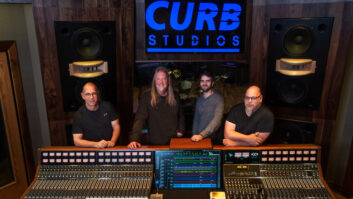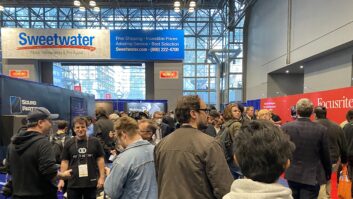Los Angeles, CA—If you visit any of the popular online pro audio forums regularly, you might be forgiven for thinking that renowned acoustician and audio engineer George Augspurger stopped working years ago. But now almost 90, and into his seventh decade in the industry, Augspurger is still busy, with a number of studio design projects currently underway in the Los Angeles area and another in Peru.
“Even though I’m old enough that I’ve slacked off and am working part-time, I’m also still doing custom monitor designs from time to time,” says Augspurger, taking time out to talk to a reporter in the lounge at one of his L.A. projects, not far from Van Nuys Airport. As with many of his studio designs, the facility, which is nearing completion, features a pair of Augspurger’s iconic soffited main monitors.
Augspurger’s in-wall mains are the stuff of legend. “The most popular configuration of the ones I did, which originated for the Village Recorder [in West Los Angeles], was two woofers in an inverted V with a high-power horn above. Of the ones I personally designed, there must be between 50 and 100, and no two are exactly alike. They’re all individually designed for particular clients.”

While studios typically feature Augspurger monitors prominently on their equipment lists, they are not all genuine examples. “From the very beginning, there have always been copies floating around,” he says. “People either manage to get a pair of my horns from some installation being torn apart or, in some cases, they reverse-engineered them and copied the high-frequency horn.”
Related: Studio Showcase: Sound City’s Urban Renewal, by Steve Harvey, Aug. 10, 2017
When it comes to speaker design, Augspurger, a fellow of both the Audio Engineering Society and the Acoustical Society of America, knows of which he speaks. He joined JBL in 1958, before he’d even finished his master’s degree at UCLA. Initially, he was put to work writing technical brochures. “I had published a bunch of articles in the tech publications, so my name was known,” he explains. He was with the company for more than a decade, during which time he established JBL Professional and led the new division as technical director, a position that consolidated engineering and sales.
Parts of the world, including the United States, were going through a Hi-Fi craze when he joined JBL, Augspurger recalls. “One of the great experiences I had, several years before, was when I heard the JBL Hartsfield demonstrated at the Hi-Fi Show in New York. I was completely blown away by what they had managed to do.”
Several years later, JBL had its first opportunity to enter the recording studio market. “In the early ’60s, when Altec Lansing was in the throes of being continually sold, the 604 [monitor speaker], which was the standard at that time, became very iffy” in terms of availability, he says. Capitol Records needed a replacement and approached JBL, where the late Bart Locanthi, the company’s vice president of engineering, came up with the design for the S7 Studio Monitor system.

“Capitol was delighted,” he says. “They immediately set it up as the standard and we suddenly had strong ties to the recording industry.” The design was subsequently modified from a sealed box to a ported enclosure for more bass extension and higher power, he adds.
When Harman acquired JBL, he continues, “I was familiar with a number of people in the recording industry, so I figured instead of giving them advice for free, I would set up my own consulting practice,” which he named Perception Inc. His consulting work has since expanded beyond recording studios to also include major film and TV facilities. Augspurger, a member of the U.S. Institute for Theatre Technology, has also worked with venues such as the Hollywood Bowl and the Dorothy Chandler Pavilion, both in Los Angeles.
Related: Clear Lake Recording Talks Monitors, Feb. 1, 2016
Augspurger doesn’t build monitors; he provides his clients with the design drawings. The horn is critical to the system’s performance, and he has long relied on just a few people to make them to precise specifications. “There were originally only three cabinetmakers in the U.S. that I trusted to make the horns, at least the ones I’ve approved—and there are lots of bootleg copies,” he says. Two fabricators have retired, he reports, but there are still two sources.
“I never claimed anything magical about the enclosure design because the enclosures vary so much. The advantage is that in a tight situation, I know enough about speaker design that I’m comfortable altering the proportions to make them fit into a particular space,” he says. One example, he says, is a pair of custom monitors that he designed for Timbaland: “They’re high-power but small, squeezed into the space that’s available in the bus.”
He is currently working with Atlantic Records on a compact monitor for the label’s production rooms. “Instead of scaling down a larger monitor, I wanted to use the full-size horn and find a pair of super-high-power 8-inch woofers. You can then augment it with a subwoofer. They were delighted with the concept,” he reports.
Related: George Augspurger Q&A, by George Petersen, June 1, 2009
Augspurger has been ideally placed to observe the changing trends in studio design over the decades. In the 1960s, he says, people like Bill Putnam built relatively small, acoustically live, mono production facilities. Once multitrack tape machines appeared, then 2-track stereo became the norm; when studios fitted with that technology ran up against the need to have space for numerous people from the record labels, control rooms began to trend larger. “The room had to be large enough to accommodate a producer’s desk, which made it sound that much better at the same time,” he says.
Augspurger contributed a generic control room design of that period to John Eargle for the last edition of his Handbook of Recording Engineering. “It was typically 18 by 23 feet, with a ceiling 9 to 11 feet high. Not totally dead, but not nearly as live as the rooms were back in the ’60s.”
As for tracking spaces, during the past 20 years, “We went from the super dry, very tight, punchy Dave Hassinger drum sounds to suddenly wanting a big, live, resonant drum sound again. Overnight, everybody wanted to work in live rooms.”
And now, as digital technology has taken hold, “There are much fewer commercial studios being built and the home market has taken over,” says Augspurger. “Here in the San Fernando Valley, every sixth house has a studio in their garage conversion. The 20-by-20 mix room with a little vocal booth is pretty much a standard configuration out here.”
Want more stories like this? Subscribe to our newsletter and get it delivered right to your inbox.






